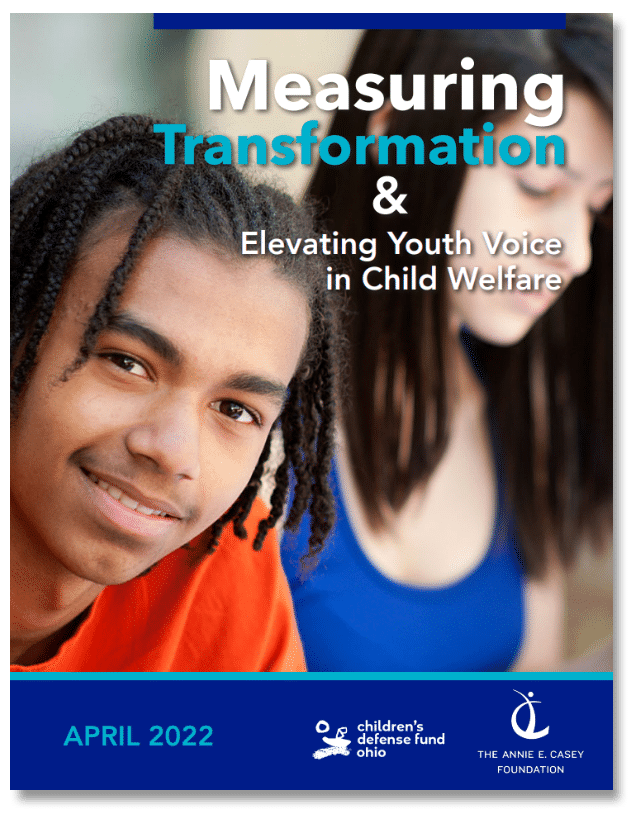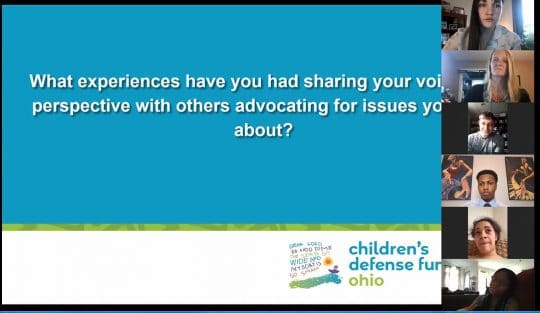Measuring Transformation and Elevating Youth Voice in Child Welfare

Leaders in Ohio recognize the need for reform and have undertaken major initiatives to improve these outcomes, such as the Children Services Transformation Advisory Council recommendations, the establishment of a Youth Ombudsman office, implementation of the Family First Prevention Services Act, and efforts to address racial equity and improve outcomes for infants through the Safe BabiesTM approach. Measuring progress will be essential to understanding the effectiveness of these reforms. The purpose of this report is to put forward specific measures that can be used by practitioners and policymakers as key indicators of change.
The bottom line is that the current measures do not fully capture the experiences of children while they are in care. Youth experience surveys should be an integral part of an agency’s practices. The data from these surveys can be used as part of a continuous quality improvement framework that makes data accessible, identifies standards, measures progress, and innovates with new practices.
Because Ohio’s child protection and children services system is county administered, the report includes a “Child Welfare Outcomes County Profile” for all 88 counties. These profiles are now available online at the Children’s Defense Fund-Ohio website as part of the KIDS COUNT Data page.
Mind the Gap: Creating a Robust Continuum of Behavioral Health Care for Young Ohioans

Mind the Gap: Creating a Robust Continuum of Behavioral Health Care for Young Ohioans, co-authored by the Children’s Defense Fund-Ohio (CDF-Ohio) and the Mental Health & Addiction Advocacy Coalition (MHAC) is the first data set of its kind to review services and supports available to each child at the county level in Ohio. Its findings reflect what communities have accomplished, identifies unmet need, and defines the factors that support development of a comprehensive Continuum of Care (CoC), which integrates physical health, health promotion and prevention, treatment, and recovery support services.
By establishing a common understanding and shared vocabulary, the report provides tangible information and concrete data to inform decision-making. Local and state policymakers and other stakeholders can take recommended actions to address gaps in the CoC.
The proposed CoC identifies the types of behavioral health services that should be available at each age and stage of development for young Ohioans prenatal up to age 26, along with their caregivers. Defining a universal CoC for Ohio’s 88 counties is a critical first step in delineating what should be available, where capacity exists, and what is needed in terms of services and opportunities for greater investments and focused attention. Using the CoC as a framework, CDF-Ohio and the MHAC surveyed the 50 Alcohol, Drug Addiction, Mental Health and Recovery Services (ADAMHS) Boards throughout Ohio on the availability of behavioral health services by age.
The information provided by the ADAMHS Boards, coupled with data from the Ohio Departments of Medicaid and Mental Health and Addiction Services, provides a roadmap for ensuring young Ohioans and their families can access and receive the behavioral health services and supports they need, when and where they need them.
Cultivating Opportunities for Youth to Flourish in Franklin County

Over the past several years, Franklin County and the City of Columbus, in partnership with local and regional stakeholders, service providers, and others, released reports and analyses exploring poverty, Opportunity Youth, and homeless youth. This report builds on the foundation of those reports, takes a fresh look at the data, and incorporates the voices of our youth and youth-serving providers and program leaders who identified continuing barriers and new opportunities.
Opportunity Youth Report Discussion
Our recent report, Cultivating Opportunities for Youth to Flourish in Franklin County, aims to ensure that Franklin County is a place of opportunity for all young people, particularly for our “Opportunity Youth” population of 16- to 24-year-olds neither in school nor working who have been separated from pathways that promise successful transitions from adolescence to adulthood. As a follow-up to the publication of the report, CDF-Ohio partnered with many of the youth-serving organizations and the Columbus Foundation to host a series of conversations focused on the report, opportunity youth, and our continued work together.
Opportunity Youth in Franklin County, Ohio

Data Gathering & Youth Voice

Human-Centered Design Thinking: Designing our Systems, Programs, & Services for Youth

Putting Research into Practice with Cloe Cooper – Youth Voice to Drive Policy

Webinar #4: In this fourth installment of the webinar series, CDF-Ohio and special guest, Cloe Cooper, discuss how to put this research and data in practice. Ms. Cooper discusses what this can look like in terms of policy actions that can be taken to help opportunity youth as they transition into adulthood.
The complete PowerPoint deck from all four webinars are available here for viewing.
Continue with us on our learning journey!
The Children’s Defense Fund-Ohio has developed a tool kit to provide teachers, school administrators, guidance counselors, social workers and other service providers practical resources to facilitate capturing youth voice as they design services that will improve outcomes for children and teens.
Youth need policies, programs, and practices that are responsive to their life circumstances. Significant training and resources have been invested to elevate our community’s awareness of trauma-informed care; however, youth report that this awareness must be translated into everyday practice.
Youth insights, perspectives, and lived experiences are integral to designing policies and programs aligned to their needs. Many schools have programs, services, and resources and youth report the need for more integration of their perspectives and insights to improve offerings, delivery approaches, and outcomes.
These key findings were a part of our recent report: Cultivating Opportunities for all Youth to Thrive in Franklin County.
The tool kit includes:
Focus Group Protocol This is a tool that can be used as a model when developing a format for doing focus groups with young people. The questions use a strengths-based approach and build on appreciative inquiry principles.
Focus Group – Demographic Survey This tool complements the focus group protocol to provide insight into the types of lived experiences that have informed the participants responses.
Consent Form Template This tool complements the youth focus group protocol and should be provided to youth prior to facilitating a focus group with them.
Survey for Organizations on Trauma-Informed Systems The audience for this tool is a team or organization who serve youth who are willing to do an honest self-assessment. The purpose of this survey is to serve as a first step to help organizations ensure that they are responsive to youth trauma and that all youth feel welcome in their environments.
Appreciative Inquiry: Here’s one I liked There are many resources available to describe appreciative inquiry. This is one that provides a concise summary that can be easily shared with colleagues as you seek partnerships in your organizations to pursue this approach toward program design.
Human-centered Design: Here’s one I liked Among the many resources available to describe human-centered design, this is one that provides a video and summary that can be easily shared with colleagues as you seek partnerships in your organizations to pursue this approach toward program design.
Civil Rights in Schools This tool provides a shared value statement that reflects the key principles that are present in safe, healthy and inclusive school climates. There are eight principles that can be viewed as a student’s “Bill of Rights” while they are under our care in schools.
Examples of trauma-informed practices in schools (2015) This tool offers practical examples of national and Ohio-specific programs that have been implemented to address trauma in schools. As a result of what we’ve learned through this experience, CDF-Ohio has created this Toolkit to capture some resources and tools that can be used.
